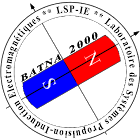, “Incipient Inter-Turn Short Circuit Fault Estimation Based on a Faulty Model Observer and ANN-Method for Induction Motor Drives,” Recent Advances in Electrical & Electronic Engineering (Formerly Recent Patents on Electrical & Electronic Engineering), vol. 12 N° 4, pp. 374-383, 2019.Abstract
Équipe 03
, “Novel Speed and Current Sensor FDI Schemes with an Improved AFTC for Induction Motor Drives,” Advances in Electrical and Electronic Engineering , vol. 16, pp. 1–14, 2018.
, “Speed Sensor Faults Diagnosis in an Induction Motor Vector Controlled Drive,” Acta Electrotechnica et Informatica , vol. 17, pp. 49–51., 2017.
, “A new flux rotor based MRAS for sensorless control of induction motor,” 5th International Conference on Systems and Control (ICSC), Marrakesh, Morocco. pp. 365-370, 2016.Abstract
, “Dynamic hysteresis modeling including skin effect using diffusion equation model,” Journal of Magnetism and Magnetic Materials, vol. 410, pp. 137-143, 2016.Abstract
, “A novel combined MPPT-pitch angle control for wide range variable speed wind turbine based on neural network,” International Journal of Hydrogen Energy, vol. 41 N 22, pp. 9427-9442, 2016.Abstract
, “Electromagnetic Field Computation in Linear Electromagnetic Actuators Using the Meshless Local Petrov Galerkin Method,” Acta Electrotechnica et Informatica, vol. 16, no. 01 January - March 2016, 2016.
, “On-Line Efficiency Improvement of Induction Motor Vector Controlled,” Advances in Electrical and Electronic Engineering journal, vol. 14, no. 3, 2016.
, “dSPACE implementation of a propulsion system using dual-induction \Real-Virtual motors,” Turkish Journal of Electrical Engineering & Computer Sciences, 2015.
, “Modélisation des Défauts de Cassure de Barres de la Machine Asynchrone par Superposition de Matrices,” 1st International Conference on Applied Automation and Industrial Diagnostics (ICAAID 2015). 2015.
, “Realisation and control of a wind turbine connected to the grid by using PMSG,” Energy Conversion and Management, vol. 84, pp. 346-353, 2014.
, “New Approach For Preisach Distribution Function Identification Using Few Experimental Data,” Acta Electrotechnica et Informatica, vol. 14, No. 3, pp. 54-60, 2014.
, “Application of an Improved Dynamic Hysteresis Model on a Non-Oriented Sheet with Mean Frequency Magnetization Field,” International Conference on Advanced Technology & Sciences (ICAT'14). 2014.
, “A Meshless Element-Free Galerkin Algorithm for Nonlinear Electromagnetic field Computatrion,” 3rd International Conference on Competetive Materials and Technology Processes (ic-cmtp3). 2014.
, “Analysis of Different Converters Used in Wind Energy Conversion System,” International Renewable and Sustainable Energy Conference (IRSEC 2014). 2014.
